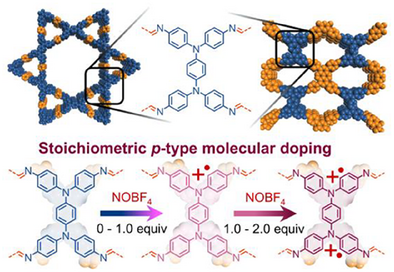Hopping-Type Charge Transport in Controllably p-Doped Polaronic Two-Dimensional Polymers
Graphical Abstract
This report explores polaron-based charge transport in controllably p-type doped 2D polymers. Substoichiometric injection of holes in 2DP lattices leads to the lowest optical bandgaps and maximal electronic conductivities. Variable-temperature conductivity reveals the existence of hopping-type transport with two distinct Arrhenius regimes, which may be related to in-plane and cross-plane directional electronic transport.
Abstract
In this work, we find that controllable p-type doping leads to Holstein-type polarons in four electron-rich two-dimensional polymers (2DPs). Substoichometrically injecting holes into these 2DPs leads to small optical bandgaps (<1.0 eV) and electrical conductivities (17 mS m−1) significantly higher than their undoped analogs. Fourier-transform infrared spectroscopy and continuous-wave electron paramagnetic resonance spectroscopy both reveal that this arises from the formation of paramagnetic polarons. We achieve maximal conductivities when 2DPs comprised of electron-rich nodes and electron-rich linkers are combined, which is a consequence of more delocalized polarons as unveiled by diffuse-reflectance UV–vis-NIR spectroscopy. Variable-temperature electrical conductivity measurements reveal two distinct Arrhenius regimes in all 2DPs investigated, which we attribute to the different thermally activated processes inherent to in-plane and cross-plane electronic transport in stacked 2DP multilayers. This resulted in a maximum electronic conductivity of 326 mS m−1 at an elevated temperature. Collectively, this report provides fundamental insight into polaron-based charge-transport in p-type 2D organic layers, which we expect will form the foundation for the eventual deployment of these materials in electronic devices.
Conflict of Interests
The authors declare no conflict of interest.
Open Research
Data Availability Statement
The data that support the findings of this study are available in the Supporting Information of this article.





